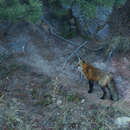More info for the term:
fruitRed foxes are omnivorous. They eat a variety of animals and plant
materials depending mainly on the availability of the food source.
Small mammals, birds, fruits, and insects comprise the bulk of the diet
[
5].
Voles (Microtus spp.), mice (Muridae), woodchucks (Marmota monax) and
several lagomorph species (eastern cottontails [Sylvilagus floridanus],
snowshoe hares [Lepus americanus], and black-tailed jackrabbits [L.
californicus]) are often preferred [
36]. In New York and New England,
meadow voles (Microtus pennsylvanicus) were the most commonly eaten prey
item. Rabbits (Sylvilagus spp.) were also commonly eaten. Throughout
most of the year in Ontario, meadow voles are the major prey,
constituting as much as 50 percent of the red fox's diet [
36].
Red foxes may also eat squirrels (Spermophilus spp.), young Virginia
opossums (Didelphis virginiana), raccoons (Procyon lotor), skunks
(Mustelidae), domestic cats (Felis catus), domestic dogs (Canis
familiaris), weasels (Mustela spp.), mink (Mustela vison), common
muskrats (Ondatra zibethicus), shrews (Soricidae), moles (Talpidae),
common porcupines (Erethizon dorsatum), pocket gophers (Geomyidae),
songbirds, crows (Corvus spp.), ring-necked pheasants (Phasianus
colchicus), northern bobwhite (Colinus virginianus), grouse
(Tetraoninae), waterfowl (Anseriformes), wild turkeys (Meleagris
gallopavo), domestic chickens, American woodcocks (Scolopax minor),
hawks (Accipitridae), owls (Strigiformes), bird eggs, turtles, and
turtle eggs. Plant foods such as grasses, sedges (Carex spp.), nuts,
berries, pears, apples, grapes, and corn, wheat, and many other grains
are eaten by red foxes. Livestock and big game are sometimes eaten as
carrion [
1,
5,
30,
36].
Seasonal variations are prominent in the diet of red foxes. The diet
generally changes from mostly animal matter in the winter to insects and
fruit in the summer and fall [
5]. Red foxes show a strong preference
for certain wild berries and fruits. During seasons of abundance,
blueberries (Vaccinium spp.), raspberries (Rubus spp.) and black
cherries (Prunus serotina) may constitute almost 100 percent of the diet
[
1].

